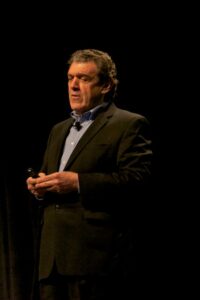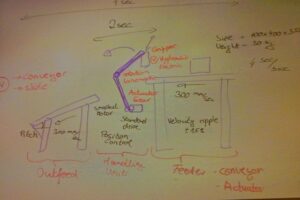
Siemens PLM is rebooting after its acquisition in 2007 and an industry-wide recession that gave everyone a chance to rethink the way they build products and go to market. Siemens PLM, with the old guard in charge, is ready to make new progress.
The Siemens PLM User Group conference was held in Las Vegas this year, far from the floods in the southern U.S. Last year floods in Nashville, Tennessee forced the User Group to shift their venue to Dallas, pushing expenses for the conference to dangerous territory for the user group. Luckily, the CAD industry is recovering from the worldwide recession of 2008 and 2009 and attendance at the Las Vegas group was good; the Siemens PLM executives were a happy bunch.
Maintaining the legacy
Last year, in 2010, Siemens PLM reached a significant milestone. When Siemens acquired UGS in 2007 it put a layer of its own management on top of its new acquisition. It seemed a relatively benign dictatorship, and short of a few culture differences between Germany and its new employees, all seemed to go smoothly. So smoothly in fact, that observers assumed the Germans were in charge and intended to stay in charge. But, last year Siemens announced that the current president of Siemens PLM, Helmuth Ludwig, was moving to IA Communications for Siemens AG. The implication being that Siemens PLM has a powerful friend at the top. Ludwig was succeeded by Charles Grindstaff, who took over as President and CTO. Longtime Unigraphics/UGS executive Tony Affuso has taken the reins over as Chairman and CEO.
This is an important issue for the customers and end users of Siemens PLM software. The new management of the company now looks a lot like the old management of the company. Grindstaff has been the Siemens CTO and EVP of Products; Affuso was the CEO of Unigraphics For some, it’s almost as if an important contract between the customers and the vendors has been renewed.
At Las Vegas the message from Siemens PLM was that the company is back on track after the recession and the company is strong, growing and innovative thanks to the influence and resources of the entire Siemens AG. Speaker Klaus Oesterschulze, Siemens Industry Group CIO, presented a detailed plan the company is putting in to place using Teamcenter to improve the efficiency of the entire company.
It was said several times that Siemens had acquired UGS in the first place because it was interested in better automating the company from the factory floor and up through management. As a result, the company would not only be more efficient as it builds its myriad products including light rail systems, water plants, baggage handling systems, energy generators, the U.S. mail postal delivery system, and health care systems and equipment, it would also be better able to understand how to help its customers build more efficient systems. In the early years of the Siemens acquisition, as a matter of fact, competitors suggested that Siemens had acquired UGS primarily for its internal use, building its own products. In that first, very quiet year, it seemed like there was truth in the story. As it turns out, there is truth in the story, but it’s a much broader strategy.
Oesterschulze describes the effort as a Lighthouse project that will integrate design, manufacture, process management, and more. “Complexity is today’s biggest challenge,” he said. “The amount of digital information increases tenfold every 5 years,” and it’s gumming up the works. As companies struggle with complexity, notes Oesterschulze, they’re not building, creating, and innovating. They’re managing. Siemens AG wants to be sure, their customers are efficient enough to keep building and they want to be efficient enough to continue innovating and creating products for their customers.

Meanwhile, Siemens PLM is growing. Affuso said Siemens has 3 million seats of PLM in the USA and 7.2 million seats overall. The company has seen five quarters of steady growth and double digit license revenue growth.

There are fierce battles going on for high-profile wins in the automotive industry. PTC, Dassault, and Siemens are the major combatants in the automotive industry and Affuso highlighted the head to head competition in which Siemens and Dassault have long been engaged. He showed the accompanying chart of automotive customers conducting technology reviews and noted that Siemens has realized significant wins this year—marked with stars in the chart. The company also showed a chart with information from the aeronautic industry, and Affuso conceded that Dassault is hanging on to its core area of strength, airframe design and manufacture. He noted that the company has made gains in the engine design industry. Although the wins seem pretty well distributed between PLM and CAD, with some intriguing digital manufacturing wins also showing up, Siemens has good momentum with Teamcenter.

Bill Carrelli, Siemens PLM Vice President of Strategic Marketing, told an audience of press and analysts at the PLM Connection conference, “CAD is no longer the center of the world. It’s at the heart of design, but it’s not a determining factor as to why people choose a platform.” It’s Siemens’ position that their customers are looking for a partner who can provide a system that improves communication and efficiency. And, when Siemens says system, they’re at pains to say they mean a system that can accommodate software from other competitors. Siemens’ calls their technology PLM Open much to the exasperation of competitors who claim they’re just as open as Siemens is. And, Siemens says, their products and the people who sell them are able to adapt to systems already in place at a company.
The company is building around its JT exchange format, which Siemens is making an open format. It has been submitted and accepted as an ISO standard, though it has not made its way through the final approval stages. Siemens PLM execs expressed no little exasperation with standards body procedures. Chuck Grindstaff described the process as “lethargic.” Siemens PLM is building their strategy around JT to improve the ability of companies working in multi-CAD environments to exchange data, but also to expand the workflow out into the factories, and into documentation, and wherever the information wants to go.
The products
Last year, the company demonstrated HD3D and HD-PLM, which Grindstaff described as a “central, shared model of your products.” HD3D enables queries to show within the model as different colored parts. HD-PLM connects users with all the information related to a model while they’re in the context of the model.
This year the company has demos to show for NX 8, which is due out in the fall. It was not an accident that the demos used by Paul Brown (NX marketing director) and Joan Hirsch (VP NX development) to describe the new features in NX 8 used an airplane frame for demonstration. It’s not only a nice huge model to demonstrate NX’s ability to navigate through huge models and access related information, but aeronautics is a big target for Siemens PLM and the company hopes the next release will take the company closer to their goal. Grindstaff also said that the company is seeing lots of opportunity for PLM in related markets including retail, apparel, consumer products, life sciences, places where Siemens AG is already playing.
The Siemens Blog includes a short, helpful video interview with Paul Brown for a overview of NX 7.5 and 8. NX 8 will also further the ability of people working within the model to access related documentation. It’s not just about content that’s in Teamcenter, but also data that’s in SAP or other business systems. Increasingly, the model becomes the center of the information flow.
Just before the Siemens PLM Connection event, the company introduced Teamcenter Mobility, an iPad app that gives users access to their Teamcenter data no matter where they are in the world. The application is expected to be used a lot on the shop floor and out in the field. In its ability to access models and data, Teamcenter Mobility dovetails nicely with the company’s HD-PLM work.

Siemens PLM is also building out its Mechatronics tools. The company is developing the Mechatronics Concept Designer (MCD). It’s built using Nvidia’s PhysX physics engine to provide feedback on mechanical operations. In action MCD looks like fun to use. It allows iterative, what-if design. Users can interact with the model while the simulation runs in order to test inputs. It’s not an accident that there’s a game engine underneath the hood of this technology. The software encourages “play” in order to find the best design.
The bottom line, or is it the top line, is that Siemens present development is geared towards helping its customers get to decisions faster and, it is hoped, with enough information to make better decisions.
What do we think?
About what? There’s a lot of information coming out of Siemens. When you think of all the areas where Siemens AG plays, Siemens PLM has advantages as a captive supplier. Teamcenter has clearly won the company some customers in automotive and the company is feeling pretty cocky about new wins in the aeronautic industry.
You can’t get too worked up about the competitive positioning slides, though, they’re only as convincing as the last company that showed them to you. The market is dynamic right now as it enters a new phase of growth. The companies working with CAD and PLM tools have gone through a very bad patch. They are leaner now, reading to start hiring again and to build again. There are wins for everyone coming down the pike.
Siemens has a window as Dassault continues its effort to integrate its products. Grindstaff took great delight in talking about Dassault’s efforts to re-architect the SolidWorks engine so that it’s the same as the CATIA engine. (Why? asked Grindstaff). He scattered around a little good-natured FUD quoting articles that said SolidWorks is headed for the cloud.
There’s another, little window that has opened up as PTC re-works its products into modules. What’s coming from PTC? How will the Creo products be different?
Finally, the Solid Edge folks didn’t get a lot of attention at Siemens PLM—it wasn’t their show (that conference comes up in June), but the company did demonstrate the latest in Solid Edge coming up, and end users are much more comfortable living in the Siemens family. After all, Synchronous Technology was developed on the Solid Edge side of the Siemens PLM family. – K.M.





